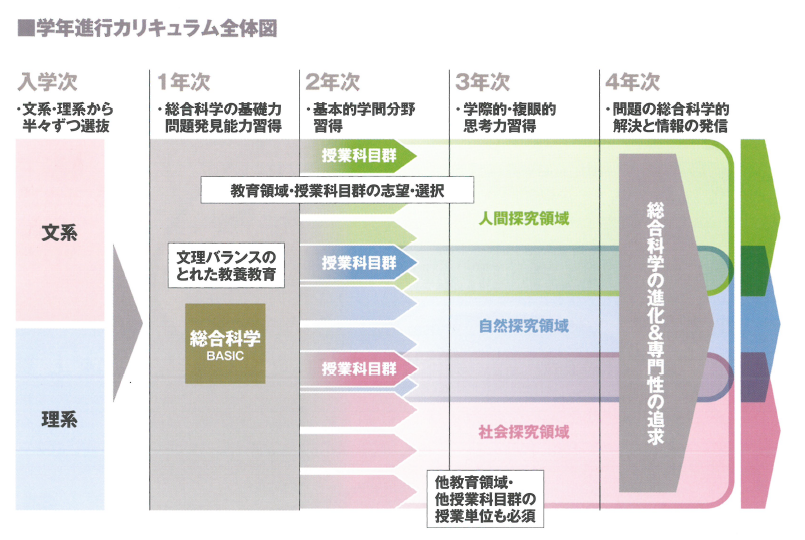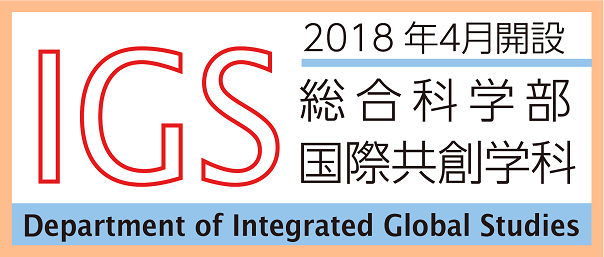Schedule and Syllabus
Studies in the School of Integrated Arts and Sciences
The compulsory subjects designed for students to learn the fundamental concept of integrated arts and sciences are provided from the first year of study. This curriculum is aimed at equipping students with an equally integrated background in both humanities and science.
1st-year students are required to take Invitation to Integrated Arts and Sciences (2 credits) in the 1st semester along with Introductory Seminar for College Education (2 credits), and Introduction to Integrated Arts and Sciences (2 credits) in the second semester. By the end of the 1st-year, students are expected to select their research area from the three divisions available (Human Research Division, Natural Sciences Research Division, and Social Studies Research Division), and further decide on their specialized core course of study included in their research area. Then, from the second year onwards, students then start to learn an Integrated Arts and Sciences approach beyond their research division and core course along with the fundamental knowledge of their own major.
Interdisciplinary and common subjects are offered for 2nd- and 3rd-year students. These are uniquely designed and offered by the School of Integrated Arts and Sciences in order to cultivate students’ Integrated Arts and Sciences approach to their studies.

School of Integrated Arts and Sciences—Original subjects
■Subjects required to learn the Integrated Arts and Sciences approach:
- Invitation to Integrated Arts and Sciences : 1st-year,1st-semester (2 credits)
Recently, the disciplines have been significantly fragmented. However, it is difficult to resolve the complex problems composed by various factors from such fractured disciplines. The course Invitation to Integrated Arts and Sciences provides a series of lectures on the history and current status of the academia, expectations and tasks for Integrated Arts and Sciences, and the history of School of the Integrated Arts and Sciences. In addition, the graduates from the faculty who are active in a society are often invited to give a lecture and students are encouraged to participate in class. Throughout the course, students should be aware that Integrated Arts and Sciences is an important and familiar academic field to them.
- Introduction to Integrated Arts and Sciences : 1st-year,2nd-semester (2 credits)
Introduction to Integrated Arts and Sciences is a course which provides detailed information about the three study areas (Humanities, Society, and Science), composed of 12 specialized fields. The course provides the foundation for students understanding of interdisciplinary subjects within independent areas and fields. Through the course, a problem based learning (PBL) approach, including interdisciplinary experiences and practical training, students improve the presentation skills they have learned in Introductory Seminar for College Education.
- Interdisciplinary Subjects after the second year
Interdisciplinary Subjects are designed to encourage students to apply their knowledge of Integrated Arts and Sciences while fostering their understanding of interdisciplinary research. These subjects consist of the lectures introducing interdisciplinary research across the three divisions (Humanities, Society and Sciences), these seminars are intended to explore and create new themes of integrated arts and sciences, and experimental and practical training to learn interdisciplinary research methodologies. These subjects are intended for the students who have already acquired knowledge in a special study area.
- Common Subjects after the second year
(The purpose of the common subjects is to improve foreign language communication skills and deepen general knowledge and promote ethics. )
Common Subject classes are designed to promote students' practical foreign language proficiency which is required in the place of research presentations. And also, it has some classes which are aimed to deepen knowledge about science and research ethics, and to cultivate critical thinking skills including the ability to make clear explanations, which are qualities that researchers and general members of society require for their futures.


 Home
Home
